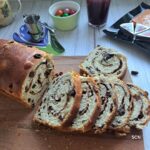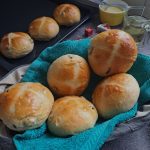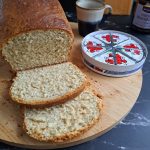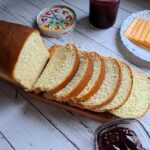Soft and Fluffy White Bread

Making soft and fluffy white bread with the addition of egg is easy and rewarding. This recipe creates a loaf that is light, tender, and perfect for all kinds of meals. The egg adds moisture and richness to the bread, giving it a beautiful texture and soft crumb. It also helps the bread rise better and gives the crust a golden colour. Whether you’re new to bread baking or have baked many loaves before, this recipe is simple and produces delicious results.
Baking bread at home may seem difficult, but with this recipe, you’ll find it much easier than you think. The key ingredients are flour, milk, yeast, sugar, salt, butter, and egg. These are basic ingredients you likely already have in your kitchen. The egg is what makes this bread special. It adds extra richness and gives a soft, fluffy texture that sets it apart from regular white bread.
Activating the yeast
To begin, you’ll need to bloom the yeast. Blooming means mixing the yeast with warm water/milk and sugar and allowing it to sit until it becomes foamy. This step ensures the yeast is active, which is important for a good rise. Once the yeast is foamy, you can add the rest of the ingredients. However, this step is optional. If you are using instant yeast and are confident about its quality, you can add it directly to the flour.
Next, mix in the flour, salt, and egg. Kneading is an important part of bread-making. Kneading helps develop the gluten, which gives the bread its structure. You can knead the dough by hand or use a stand mixer with a dough hook. Once the dough is smooth and elastic, it’s time to let it rise.
Place the dough in a bowl, cover it, and let it rise in a warm place for about an hour or until it doubles in size. After the first rise, punch down the dough to release any air bubbles and shape it into a loaf. Put the dough in a greased loaf pan and let it rise again for about 30 minutes.
Finally, it’s time to bake. Bake the bread in a preheated oven until the top is golden brown, and the loaf sounds hollow when tapped. The egg in the dough helps to bake evenly and creates a soft, golden crust. After baking, let it cool before slicing. It’s tempting to cut into it right away, but cooling helps the bread finish setting.
This soft and fluffy white bread with egg is versatile. You can use it to make sandwiches, or toast, or enjoy it with butter and jam. The richness of the egg gives the bread a wonderful flavour, making it a great choice for breakfast, lunch, or dinner. Once you try this recipe, you’ll find it hard to go back to store-bought one! It’s fresh, homemade, and tastes amazing.
Love baking bread? Check out our collection of delicious bread recipes, from hearty whole-grain loaves to sweet raisin cinnamon bread!




Soft and Fluffy White Bread
Ingredients
1 cup = 250ml
- 3 – 3 ½ cups (375 – 440 gms) of all-purpose flour
- 2 tsp instant dry yeast
- 2 tbsp sugar
- 1 tsp salt see notes
- 1 cup 250ml luke-warm milk (between 35°C – 40°C)
- 1 room-temperature egg
- 2 tbsp unsalted butter melted
- 1 tbsp milk for brushing the top
- Extra butter for greasing the pan and brushing the top
Instructions
- In a stand mixer bowl, combine 3 cups of flour, and salt. Mix them.
- Add the sugar, instant yeast, egg and melted butter
- Use the stand mixer with a dough hook attachment to knead the dough. Mix until a sticky dough forms.
- Gradually add the remaining flour as you knead the dough for about 8-10 minutes on medium-low speed until it becomes smooth, elastic, and slightly tacky.
- Kneading by hand does take more time and effort, so double the time for kneading by hand to achieve the right dough texture. This helps develop the gluten properly for a good rise and soft texture.
- Grease a large bowl with butter.
- Place the dough in the bowl, turning it to coat all sides with the butter.
- Cover the bowl with a clean kitchen towel or plastic wrap.
- Let the dough rise in a warm place for about 1-2 hours, or until it doubles in size.
Shape the Dough:
- Turn it out onto a lightly floured surface and shape it into a loaf by rolling it into a tight cylinder.
- Pinch the seams to seal.
- Grease a 9×5-inch loaf pan with butter.
- Place the shaped dough into the pan, seam side down.
- Cover it again and let it rise for another 45 minutes to 1 hour, or until it has risen about an inch above the edge of the pan.
Bake the Bread:
- Preheat your oven to 190°C.
- Bake the bread for 25-30 minutes, or until the top is golden brown and the bread sounds hollow when tapped.
- If the top browns too quickly, you can cover it loosely with aluminium foil halfway through baking.
Cool and Serve:
- Remove the bread from the oven and immediately brush the top with a bit of melted butter for a soft crust.
- Let the bread cool in the pan for 10 minutes, then turn it out onto a wire rack to cool completely.
- Enjoy your homemade white bread fresh, or use it for sandwiches, toast, or any of your favourite recipes!
Notes
Frequently Asked Questions
Yes, you can use active dry yeast. Don´t forget to bloom it before adding it to the flour.
Bread flour works best because it has a higher protein content, which helps develop gluten and gives the bread its structure. However, all-purpose flour can also be used for a slightly softer loaf.
The dough should be smooth, elastic, and slightly tacky. If you pull a piece of dough, it should stretch without tearing easily. You can also perform the “windowpane test” by stretching a small piece of dough until it forms a thin, translucent membrane.
Several factors can affect the rise. The yeast may have been inactive, the water may have been too hot or too cold, or the dough might not have been kept in a warm enough environment during proofing. Make sure to check your yeast quality and the temperature.
Yes, you can make white bread without eggs, but the texture and flavour will differ slightly. The egg adds richness and moisture, so you may need to adjust the liquid content to compensate.
Store your bread in an airtight container at room temperature for 2-3 days. For longer storage, you can slice the bread and freeze it. Just wrap it tightly in plastic wrap or foil and store it in a freezer-safe bag.
Dense bread can result from under-proofing, over-kneading, or adding too much flour. Ensure the dough rises fully during both proofing stages and avoid adding excessive flour during kneading.
Yes, you can definitely knead the dough by hand. If you’re kneading by hand, it takes around 20-25 minutes of consistent kneading to achieve the right gluten development. Make sure the dough becomes smooth and elastic. You can test if it’s ready by doing the “windowpane test” — stretch a small piece of dough gently between your fingers; if it stretches thin without tearing, it’s well-kneaded.
A hard crust can be caused by over-baking or baking at too high a temperature. Make sure to bake at the correct temperature and monitor the bread for doneness to avoid overcooking.
The bread should have a golden brown crust and sound hollow when tapped on the bottom. You can also use a thermometer to check the internal temperature, which should be around 190-200°F (88-93°C).

6 thoughts on “Soft and Fluffy White Bread”